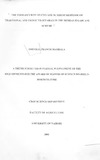The food security status and nutrient response of traditional and exotic vegetables in the Mumias sugarcane scheme
Abstract
A baseline study was conducted in October-November, 2000 in Mumias Sugarcane
Scheme (MSS) to determine the potential of vegetables on food security of smallholder
farmers. The survey covered 108 participating farmers. Effects of recommended inorganic
fertilizer level and farmyard manure on growth, yield and nutritive quality of three
vegetables were determined in on-farm experiments conducted during the 2000 short rains
(SR) and 2001 long rains (LR). The vegetables included collard (Brassica oleraceae var
acephala D.C.), an exotic leafy vegetable, and two traditional ones, eat's whiskers
(Cleome gynandra (L.) Briq.) and amaranth (Amaranthus lividus L.). The vegetables were
grown under two fertilizer treatments of recommended inorganic fertilizer level (RFL) at
50 kg Nitrogen (N) ha-l and 50 kg Phophorus pentoxide (P20S) ha-l and farmyard manure
(FYM) at 20 tonnes ha" .dry weight, and control (no fertilization). Treatments were laid
out in a randomized complete block design in a split-plot arrangement with crop species
and fertilizer types as main and sub-plot factors, respectively. Growth. yield. j3-carotene
and iron content were determined.
The results showed that the land allocated to vegetable production compared to
other crops was very little. The ranking of various crops in order of importance showed
that vegetables enjoy low status with traditional vegetables faring worse than exotic
vegetables. Proper agronomic practices in particular fertilizer application and pest control
are not well adopted. Therefore, there is little self-sufficiency of vegetables. which
contributes to food insecurity. Fertilizer application whether RFL or FYM led to higher
growth as shown by plant height, girth and total dry matter (TDM ) and yield in the
traditional vegetables. However, collard did not show any difference in height under
different fertilizers. Traditional vegetables showed higher heights under FYM at all
growth stages. In all the crops, FYM led to higher fresh leaf yields compared to RFL.
Among the crop species, collard produced higher fresh leaf yields than traditional
vegetables in the SR, however, the yields of the three crops were same in the LR.
Generally, higher fresh leaf yields were realized during the SR in all the crops. Fertilizer
application did not affect both B~carotene and iron contents. B~carotene and iron contents
did not differ among the crops. Fertilizer use should be encouraged to improve growth and
yield of vegetables.
Citation
Master of Science in HorticulturePublisher
University of Nairobi Department of Crop Science

